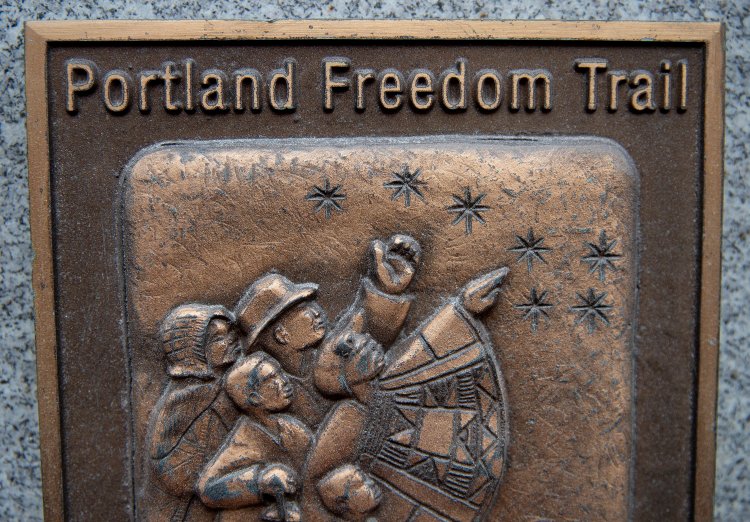Portland’s Black history is easier to find than you might think.
All around the Old Port and Munjoy Hill, there are sites that were important to the Black experience in Maine.
Finding them is as easy as picking up a map and taking a walk.
February is Black History Month, a good time to rediscover the Portland Freedom Trail, established in 2007. A group that included current Maine House Speaker Rachel Talbot Ross and noted artist Daniel Minter picked sites that were important because of their role in the Black community and in the Underground Railroad, the organized resistance to slavery that included efforts to help slaves escape the South.
Organizers wrote at the time that the trail was dedicated “to the countless thousands of men and women who fled the bonds of slavery but were recaptured or died at the hands of their pursuers before they reached the safe embrace of the Underground Railroad. They are not forgotten.”
The 13 sites along the trail are not organized in any particular order, so you can start at any one you wish and just visit others close by. Or because the spots are relatively close together on Portland’s peninsula, you could walk to all the sites in about an hour or so, depending on your pace.
The Portland Freedom Trail self-guided walking tour guide and map lists all the sites, with detailed information about why each one is important. At some, original buildings still stand; at others, the guide tells you what was there. There is also a granite and bronze marker at each site, with information and an artistic carving.
You can download and print the Portland Freedom Trail guide and map at the website of the Maine Historical Society, mainehistory.org.
Below are a few of the sites along the trail and why they are important.

FRANKLIN STREET WHARF: This wharf was located where the Casco Bay ferries dock today and was a busy shipping hub in the days when vessels sometimes arrived in Portland with a stowaway slave on board. One was the British ship Albion Cooper, carrying lumber from Georgia, which arrived in Portland in the fall of 1857 with an enslaved man on board, as a stowaway. Locals, led by Samuel Waterhouse, arranged for a group of anti-slavery supporters and Black men to board the ship at night and take the runaway, secretly, through Portland, to a hiding spot. He was kept there until he could be safely sent to Canada, and freedom.
BARBER SHOP OF JACOB C. DICKSON: In 1840s Portland, Dickson’s shop at 243 Fore St. was a center of the local anti-slavery movement, and barber shops in general were places to get and give information about the Underground Railroad. According to the Portland Freedom Trail guide, wigs and beards at the shops were used to change somebody’s appearance, and barbers often cooperated with hack drivers and second-hand clothing dealers to help get enslaved people to freedom. Dickson was elected secretary of the Portland Union Anti-Slavery Society in 1842.

The Abyssinian Church, now the Abyssinian Meeting House, served as the major center of the Underground Railroad in Maine and a social center for Portland’s African American community. Derek Davis/Staff Photographer
ABYSSINIAN MEETING HOUSE: Still standing at 73-75 Newbury St., this was a major hub on the Underground Railroad and was a social center for the Black community. Reuben Ruby, a well-known activist and Underground Railroad “conductor,” bought the land for the church, which was built in 1829. Ruby, who worked with national anti-slavery leader William Lloyd Garrison, had a “hack stand” at the corner of Federal and Temple streets, where he had a coach and horses for transporting passengers. The site of his hack stand is also on the trail.
MARINERS’ CHURCH: This building, still standing at the corner of Fore and Moulton streets, was built as a church for waterfront workers. But the basement contained an anti-slavery bookstore and a print shop, owned by Daniel Colesworthy. In 1836, he printed “Light and Truth from Ancient and Sacred History” by Black author Robert Benjamin Lewis, a history of the world with a focus on people of African descent and their contributions.

The intersection of India and Middle streets in Portland, near where Charles H. L. Pierre’s hack stand stood in the mid-1800’s, a stop on the Portland Freedom Trail. Derek Davis/Staff Photographer
EASTMAN AND STEPHENSON HOME: Alexander Stephenson, who was an active member of the local Black community, worked as a hotel porter. He lived in the house at the corner of Mountfort and Newbury streets with his daughter Harriet and her husband, Charles Frederick Eastman. According to his obituary when he died in 1889, Eastman was a conductor on the Underground Railroad, a barber, a secondhand clothing dealer, a hack driver, a mariner, a taxidermist and the owner of a substantial library.
ELIAS AND ELIZABETH WIDGERY THOMAS HOME: The home at 53 India St. was known as a “safe house” for enslaved people running away. The family included members of the anti-slavery movement and, at various times, played host to such notable activists of the 1800s as Susan B. Anthony, William Lloyd Garrison and Parker Pillsbury. The home was destroyed in Great Fire of 1866.
Copy the Story LinkSend questions/comments to the editors.




Success. Please wait for the page to reload. If the page does not reload within 5 seconds, please refresh the page.
Enter your email and password to access comments.
Hi, to comment on stories you must . This profile is in addition to your subscription and website login.
Already have a commenting profile? .
Invalid username/password.
Please check your email to confirm and complete your registration.
Only subscribers are eligible to post comments. Please subscribe or login first for digital access. Here’s why.
Use the form below to reset your password. When you've submitted your account email, we will send an email with a reset code.